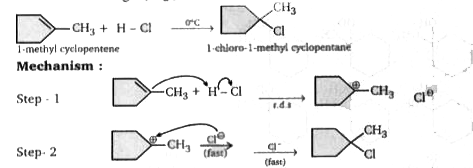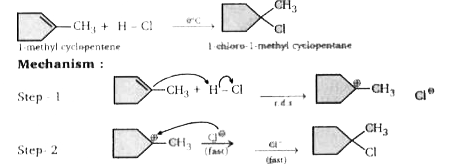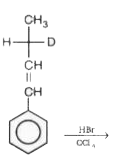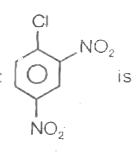Assertion: Vinyl halides do not undergo substitution reaction.
Reason: Although the cation is stablished by loosely bound π-electron cloud, it least occurs due to high bond strength.
Both (A) and (R) are correct statements and (R) is the correct explanation of (A)
Both (A) and (R) are wrong statements
Both (A) and (R) are correct statements but (R) is not the correct explanation of (A)
(A) is correct statement but (R) is a wrong statement
The correct Answer is:D
In Vinyl Halides CH2a=CHoveret(b)(−)X, the strength of the bond (b) is very high due to delocalisation such that the Vinyl carbocation is highly unstable.
Topper's Solved these Questions
Similar Questions
Assertion: Aryl halides undergo nucleophilic substitution reactions with ease.
Reason:The carbon halogen bond in aryl halides has partial double bonds character.View SolutionRead the given passage and answer the questions number 1 to 5 that follow:
The substitution reaction of alkyl halide mainly occurs by SN1 and SN2 mechanism. Whatever mechanism alkyl halides follow for the substitution reaction to occur, the polarity of the carbon halogen bond is responsible for these substitution reactions. The rate of SN1 reactions are governed by the stability of carbocation whereas for SN2 reactions steric factor is the deciding factor. If the starting material is a chiral compound, we may end up with an inverted product or racemic mixture depending upon the type of mechanism followed by alkyl halide. Cleavage of ethers with HI also governed by steric factor and stability of carbocation, which indicates that in organic chemistry, these two major factors help us in deciding the kind of product formed
1. Predict the stereochemistry of the product formed if an optically active alkyl halide undergoes substitution reaction by SN1 mechanism.
2. Name the instrument used for measuring the angle by which the plane polarised light is rotated.
3. Predict the major product formed when 2-Bromopentane reacts with alcoholic KOH.
4. Give one use of CHI3
5. Write the structures of the products formed when anisole is treated with HI.View Solution
Knowledge Check
- Question 1 - Select One
Assertion: Rotation about C=C is restricted.
Reason: Electron charge cloud of the π bond is located above and below the plane of bonding atoms.AIf both assertion and reason are true and reason is the correct explanation of assertionBIf both assertion and reason are true but reason is not the correct explanation of assertionCIf assertion is true but reason is false.DIf both assertion and reason are false. - Question 2 - Select One
Vladimir Markovnikov rule : Alkenes undergo electrophilic addition reactions. It is triggered by the acid acting as a electrophile toward t-electrons of the double bond. Markovnikov's rule states that when an unsymmetrically substituted alkene reacts with a hydrogen halide, the hydrogen atom adds to the carbon that has the greater number of hydrogen, e.g.,

In which of the following reactions, product is racemic mixture ?ACH3−CH2−CH=CH2HBr−−→CCl4B C
C DAll of these
DAll of these - Question 3 - Select One
Vladimir Markovnikov rule : Alkenes undergo electrophilic addition reactions. It is triggered by the acid acting as a electrophile toward t-electrons of the double bond. Markovnikov's rule states that when an unsymmetrically substituted alkene reacts with a hydrogen halide, the hydrogen atom adds to the carbon that has the greater number of hydrogen, e.g.,

In which of the following reactions, diastereomers will be formed ?A B
B C
C DAll of these
DAll of these
Statement-I: Vinylic halides are reactive towards nucleophilic substitution reaction.
Because Statement-II: Reactivity is due to the polarity of carbon-halogen bond.View SolutionAryl halides do not undergo uncleophilic substitution reactions under ordinary conditions because
(1) Approach of nucleophile is retarded
(2) Carbon carrying halogen atom is sp3 hybridised
(3) The substrate molecule is destabilised due to resonance
(4) Partial double bond character between carbon and halogenView SolutionWhen an atom or an ion is missing from its normal lattice site, a lattice vacancy (Schottky detect) is created In stoichiometric ionic crystals, a vacancy of one ion has to be accompanied by the vacancy of the oppositely charged ion in order to maintain electrical neutrality.
In a Frenkel defect an ion leaves its position in the lattice and occupies an interstitial void.This is the Frenkel defect commonly found along with the Schottky defects and interstitials.In pure alkali halides, Frendel defect are not found since the ions cannot get into the intenstitial sites.Frenkel defects are found in silver halides because of the small size of the Ag+ ion.Unlike Schottky defects. Frenkel defects do not change the density of the solids.In certain ionic solids (e.g. AgBr) both Schottky and Frenkel defects occur.
The defects discussed above do not disturb the stoichiometry of the crystalline meterial.There is large Such solids showing deviations from the ideal stoichiometric composition form an important group of solids For example in the vanadium oxide, VOx, x can be anywhere between 0.6 and 1.3.There are solids which are difficult to prepare in the stoichiometric composition.Thus, the ideal composition in compounds such as FeO is difficult to obtain (normally we get a composition of Fe0.85O but it may range from Fe0.93 O to Fe0.96O).Non-stoichiometric behaviour is most commonly found for transition metal compounds through is also known for some lanthanoids and actinodes.
Zinc oxide loses oxygen reversibly at high temperature and turns yellow in colour.The excess metal is accomdated interstitially, giving rise to electrons trapped in the neighbourhood.the enhanced electrical conductivity of the non-stoichiometric ZnO arises from these electrons .
Anion vacancies in alkali halides are produced by heating the alkali halide crystals in an atmosphere of the alkali metal vapour.When the metal atoms deposite on the surface they diffuse into the crystal and after ionisation the alkali metal ion occupies cationic vacancy whereas electron occupies anionic vacancy.Electrons trapped in anion vacancies are referred to as F-centres (from Farbe the German word for colour) that gives rise to interesting colour in alkali halides.Thus, the excess of potassium in KCl makes the crystal appear violet and the excess of lithium in LiCl makes it pink.
In the crystal of Fe0.93O, the percentage of Fe (II) will beView SolutionWhen an atom or an ion is missing from its nomal lattice site a lattice vacanecy (Schottky defect) is created. In stoichmeteric ionic crystals, a vacancy of one ion has to be accompanied by the vacancy of the oppositely charge ion in order to maintain electrical neutrality.
In a Frenkel defect an ion leaves its position in the lattice and occupies an interstitial void. This id the Frenkel defect commonly found along with the Schottky defects and interstitial. In pure alkali halides. Frenked defects are not found since the ions cannot get into the interstitial sites. Frenkel defects are found in silver halides because of the small size of the Ag+ ion. Unike Schottky defects, Frenkel defect do not change the density of the solids. in certain ionic solids (e.g., AgBr) both schottky and Frenkel defect occur.
The Defects idiscussed above do not disturb the stoichiometery of the crystalline material. there is large variety of non-stoichiometric inorganic solids which contains an excess or deficienty of one of the elements. Such solids showing deviations from the ideal stoichiometric composition from an important group of solids. For example in the vanadium oxide, VOx,x can be anywehere between 0.6 and 1.3 there are solids such as difficult to prepare in the soichiometric omposition thus, the ideal composition in compounds such as FeO is difficult to obtain (normally we get a compositiion of Fe(0.95)O but it may range from Fe0.93O to Fe0.96O). Non-stoichiometric behavious is most commonly found for transition metal compounds through is also known for some lathanoids and actinoids.
Zinc oxide loses oxygen reversible at high temperature and turns yellow in colour. the excess metal is accomodated interstitial, giving rise to electrons trapped in the neighbourhood, the enchanced electrical conductivity of the non-stoichiometric ZnO arises from these electrons.
Anion vacancies in alkali halides are produced by heating the alkali halid crystals in an atmosphere of the alkali metal vapour. when the metal atoms deposit on the surface they diffuse into the cystal and after ionisation the alkali metal ion occupies cationic vacancy whereas electron occupies anionic vacancy. Electrons trapped i anion vacancies are referred to as F-centers (From Farbe the German word for colouf) that gives rise to interesting colour in alkali halides. Thus, the excess of potassium i KCl makes the crystal appear violet and the excess of lithium in LiCl makes it pink.
Which of the following is most appropritate crystal to show Frenkel defect ?View SolutionIn the following questions, a statement of assertion (A) is following by a statement of reason (R )
 is more reactive towards nucleophilic substitution reaction than
is more reactive towards nucleophilic substitution reaction than 
R: NO2 group is electron withdrawaing so decreases the double bond of C-CI bond .View Solution

